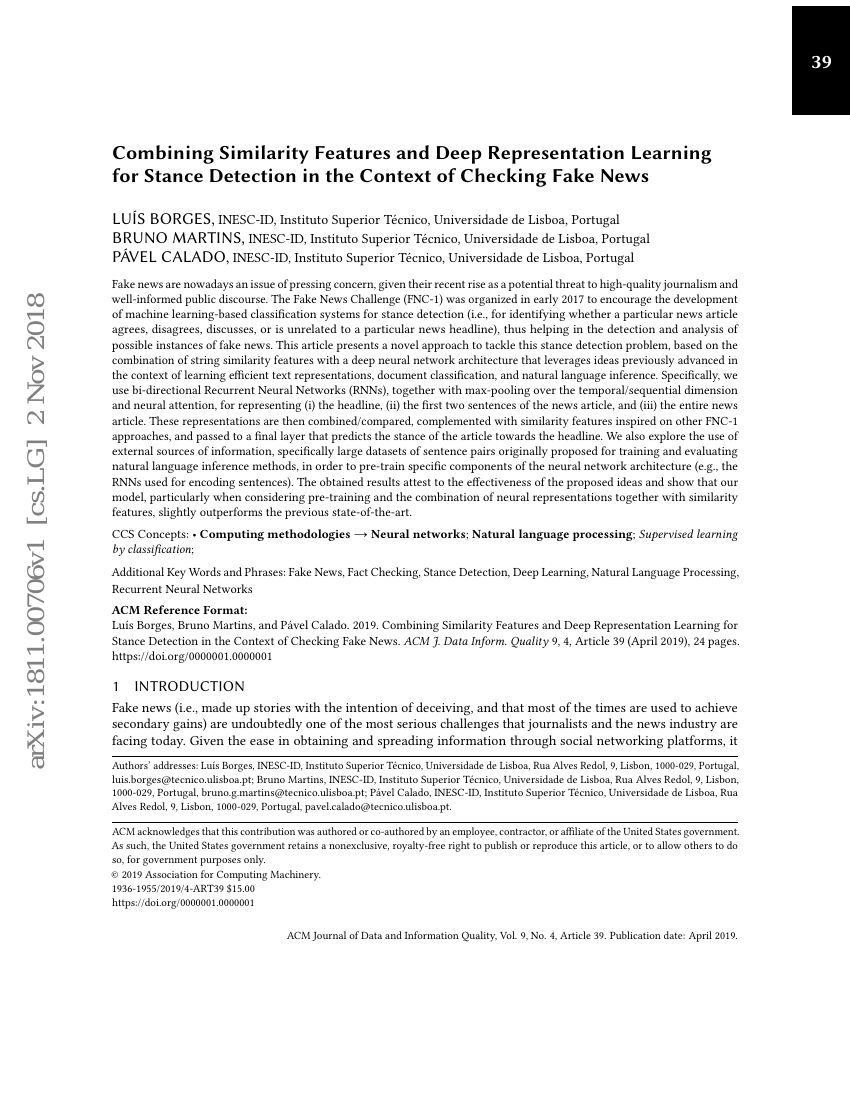Command Palette
Search for a command to run...
Combining Similarity Features and Deep Representation Learning for Stance Detection in the Context of Checking Fake News
Luís Borges; Bruno Martins; Pável Calado

Abstract
Fake news are nowadays an issue of pressing concern, given their recent rise as a potential threat to high-quality journalism and well-informed public discourse. The Fake News Challenge (FNC-1) was organized in 2017 to encourage the development of machine learning-based classification systems for stance detection (i.e., for identifying whether a particular news article agrees, disagrees, discusses, or is unrelated to a particular news headline), thus helping in the detection and analysis of possible instances of fake news. This article presents a new approach to tackle this stance detection problem, based on the combination of string similarity features with a deep neural architecture that leverages ideas previously advanced in the context of learning efficient text representations, document classification, and natural language inference. Specifically, we use bi-directional Recurrent Neural Networks, together with max-pooling over the temporal/sequential dimension and neural attention, for representing (i) the headline, (ii) the first two sentences of the news article, and (iii) the entire news article. These representations are then combined/compared, complemented with similarity features inspired on other FNC-1 approaches, and passed to a final layer that predicts the stance of the article towards the headline. We also explore the use of external sources of information, specifically large datasets of sentence pairs originally proposed for training and evaluating natural language inference methods, in order to pre-train specific components of the neural network architecture (e.g., the RNNs used for encoding sentences). The obtained results attest to the effectiveness of the proposed ideas and show that our model, particularly when considering pre-training and the combination of neural representations together with similarity features, slightly outperforms the previous state-of-the-art.
Code Repositories
Benchmarks
| Benchmark | Methodology | Metrics |
|---|---|---|
| fake-news-detection-on-fnc-1 | Bi-LSTM (max-pooling, attention) | Per-class Accuracy (Agree): 51.34 Per-class Accuracy (Disagree): 10.33 Per-class Accuracy (Discuss): 81.52 Per-class Accuracy (Unrelated): 96.74 Weighted Accuracy: 82.23 |
| natural-language-inference-on-multinli | Bi-LSTM sentence encoder (max-pooling) | Matched: 70.7 Mismatched: 71.1 |
| natural-language-inference-on-multinli | Stacked Bi-LSTMs (shortcut connections, max-pooling, attention) | Matched: 70.7 Mismatched: 70.5 |
| natural-language-inference-on-multinli | Stacked Bi-LSTMs (shortcut connections, max-pooling) | Matched: 71.4 Mismatched: 72.2 |
| natural-language-inference-on-snli | Stacked Bi-LSTMs (shortcut connections, max-pooling, attention) | % Test Accuracy: 84.4 |
| natural-language-inference-on-snli | Bi-LSTM sentence encoder (max-pooling) | % Test Accuracy: 84.5 |
| natural-language-inference-on-snli | Stacked Bi-LSTMs (shortcut connections, max-pooling) | % Test Accuracy: 84.8 |
Build AI with AI
From idea to launch — accelerate your AI development with free AI co-coding, out-of-the-box environment and best price of GPUs.